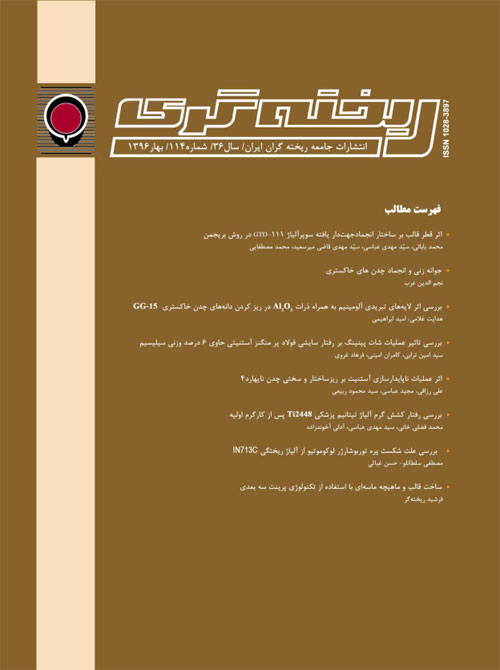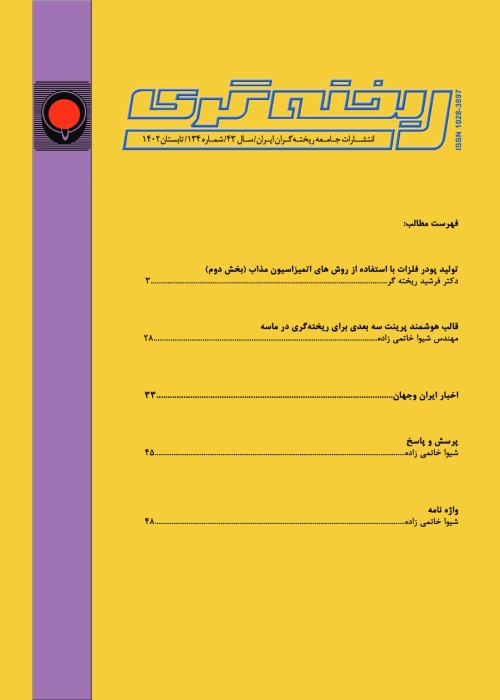فهرست مطالب

نشریه ریخته گری
پیاپی 114 (بهار 1396)
- تاریخ انتشار: 1396/03/30
- تعداد عناوین: 8
-
-
اثر قطر قالب بر ساختار انجماد جهت دار یافته سوپر آلیاژ GTD-111 در روش بریجمنصفحه 2
-
جوانه زنی و انجماد چدن های خاکستریصفحه 9
-
بررسی اثر لایه های تبریدی آلومینیم به همراه ذرات Al2O3 در ریز ردن دانه های چدن خاکستری GG-15صفحه 14
-
بررسی تاثیر عملیات شات پینینگ بر رفتار سایشی فولاد پر منگنز آستنیتی حاوی 6 درصد وزنی سیلیسیمصفحه 19
-
اثر عملیات ناپایدارسازی آستنیت بر ریزساختار و سختی چدن نای هارد 4صفحه 25
-
بررسی رفتار کشش گرم آلیاژ تیتانیم پزشکی Ti2448 پس از کارگرم اولیهصفحه 33
-
بررسی علت شکست پره توربوشارژر لوکوموتیو از آلیاژ ریختگی IN713Cصفحه 41
-
ساخت قالب و ماهیچه ماسه ای با استفاده از تکنولوژی پرینت سه بعدیصفحه 46
-
The Effects of Diameter Variation in Bridgman Directional Solidification Technique on Structure of GTD-111Page 2In this study the effects of diameter variation in Bridgman directional solidification technique on structure of Ni-base superalloy GTD-111 has been investigated. So the samples with diameters of 22 and 29 mm were selected that at 5 mm/min withdrawal rate were directed. Thus the effect of this variation on structure contain density of grains, deviation orientation, primary and secondary dendrite arm spacing, volume fraction of γ-γ' eutectic, the number of freckle and average size of γ' particle were evaluated. It was observed increasing diameter cause density of grains decreased but the deviation orientation, primary and secondary dendrite arm spacing, volume fraction of γ-γ' eutectic, the number of freckle and average size of γ' particle increased. Therefore, the review of the alloy structure revealed that by increasing the diameter due to reduced cooling rate, the possibility of inappropriate structure increases. Therefore, it was suggested that in directional casting of large section in Bridgeman method, the decrease of cooling rate should be compensated by increasing the optimal withdrawal rate.Keywords: Ni-base Superalloy, Directional Solidification, Bridgman Technique, Diameter Variation, Macrostructure, Microstructure
-
Inoculation and Solidification of Grey Cast IronsPage 9To improve the quality of casting, the inoculation and solidification of grey cast iron was investigated. The investigation shows, there is a competitive behavior between the nucleation sites and undercooling. Increasing the nucleation sites and undercooling, have grain refining effects, but increase each one decrease the other, so to optimum grain refining, it is necessary to obtain an optimum condition in both.Keywords: Cast Iron, Grey Cast Iron Solidification, Inoculation, Undercooling, Nucleation Sites
-
Effect of the Aluminum chilled layer with tiny particles Al2O3 in grain refinement gray iron GG-15Page 14In this study the effects of chille layer of aluminum particles with low Al2O3 TRACE level on properties such as hardness and strength of pearlitic cast iron GG-15 and between the layers have been investigated. The results indicate that The aluminum structure of the GG-15, which has a ferritic structure into pearlite, carbide and reduced distance between the lower layers of the perlite.
The results of X-ray diffraction showed the presence of metal particles such Fe3AL; FeAL3; FeAL and ALFe3C0.5because AL is in the structure. AL, and increased with increasing hardness and strength due to the presence of metal compounds and also increase the percentage of perlite and perlite is to reduce the layers.Keywords: Cast iron GG, 15-Layers of refrigeration, Ferrite- Perlite, Alumina-Microstructure -
Investigation on Effect of Shot Peening on the wear behavior of high manganese austenitic steels with 6 percent siliconPage 19In this study, the wear behaviour of high-manganese- silicon austenitic steel with a nominal composition of Fe-17Mn-1.5Cr-6Si-1.2C with initial work hardening via shot peening were investigated. For this purpose, samples casted in sand moulds were solutionized annealing at the temperature of 1100 °C for 2 hours and then quenched in water. After that the samples were produced in the final shapes via wire cut machine. Initial work hardening was performed via shot peening of samples for 15 and 30 minutes. The hardness and wear behaviour was evaluation via the abrasive-wheel with dry sand. For microstructural analysis, the optical microscope and for evaluating the worn-out surface of the samples the scanning electron microscopy were used. Results show that increasing the period of shot peening improves the hardness from 368 to 661 and 748 HV in the 15 and 30 minutes peening respectively. Therefore, in the samples with higher hardness, the wear rate decreases (55%) and hence less weight loss is observed. Beyond this, the predominant wear mechanism was abrasive wear due to the parallel scratches on the worn-out surface of the samples. Initial work hardening, increases the hardness and hence number and depth of scratches decreases vividly.Keywords: High Manganese?high silicon steel, Shot Peening, Work Hardening, Hardness, Wear resistance
-
Effect of Destabilization of Austenite on the Microstructure and Hardness of Ni-Hard 4 Cast IronPage 25The effects of destabilizing time and temperature on the microstructure and hardness of Ni-hard 4 cast iron were evaluated. Destabilizition of the samples were done four temperatures and six times. Microstructural evaluation were done using optical and scanning electron microscope equiped with EDS amd XRD and microhardness measurings were done using vickers method. The results showed that during destabilizing heat treatment, secondary carbides are precipitated and therefore dissolved carbon and chroumium in austenite are decreased. Then more martensitic transformation is achieved and the hardness is increased. Optimal condition for destabilizing is selected in 800-850°C for 4-5 hours.Keywords: Ni-hard 4 Cast Iron_Eutectic Carbide_Destabilization of Austenite_Microstructure
-
Investigation of hot tensile behavior of biomedical Ti2448 alloy after initial hot workingPage 33In this research of hot tensile temperature and strain rate on the microstructure and hot tensile properties of Ti2448 alloy has been investigated. For this purpose, tensile test has done as a function of temperature (700- 900˚C) and strain rate (έ=0.01, 0.1 and 1 s-1). With increasing hot tensile temperature, ductility has been in beta phase. During hot tensile in 850 and 900˚C, homogenous deformation has been observed as result of counterbalancing between dynamic recovery and strain hardening. Similarity of microstructure and equal volume fraction of alpha phase resulting equal ductility in the range of 700-800˚C. Microstructure examination shows that β→α transformation has been increased. During αβ deformation, β→α transformation has been accelerated as a result of high volume fraction of preferred nucleation sites.Keywords: Ti2448 alloy, Dynamic recovery, Elongation, Strain induced phase-transformation, high temperature tensile behavior
-
Fracture Analysis of the Locomotive Turbocharger Blade of Cast Alloy IN713CPage 41Understanding the fracture reasons and ineffectiveness of IN713C cast blades are essential in order to terminate these failures, as the fracture of turbocharger blades in locomotives are detrimental. These blades are one of the main and important parts in locomotives. Sudden fracture of these blades may cause catastrophic damages in the turbine. In this research, origin of the fracture is evaluated by the metallurgical aspects. Consequently, chemical analysis, hardness test, metallographic examination, and fracture surface analysis were performed. From the results, it is concluded that the fracture of the blade is mainly caused by the simultaneous effect of distribution and inappropriate morphology of carbide phases, a great number of shrinkage cavities, as well as segregation during casting process.Keywords: Blade, Turbocharger, Carbide, Fracture, Casting, Cavity, Segregation
-
Manufacturing of sand core and mold using 3D printing technologyPage 46During recent years, the application of additive manufacturing/3D printing has been increased for rapid prototyping and manufacturing of mold cavity and tool inserts in casting industry. A common method in this category is powder- binder jetting process which in its procedure, the initial CAD data is divided to many layers with the same thickness and then, the powder bed is exposed to the phenolic resin based binder jetting in X-Y plane to make the contour of model in related layer and this process continues to complete the final product layer-by-layer. In this way, many of sand molds and cores can be produced consisting individual and complex geometries which leads to increasing the production rate and freedom in design to present different models and also decreasing the manufacturing costs with eliminated tooling. In this paper, in the course of comparison of advantages and limitations of sand casting, the characteristics of powder- binder process has been explained which is an important subcategory of 3D printing technology, and some applicable sand-printed samples produced by this method have been shown to use in mold making step of sand casting.Keywords: Additive Manufacturing, 3D Printing, Sand Casting


